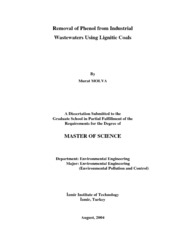Please use this identifier to cite or link to this item:
https://hdl.handle.net/11147/3256Full metadata record
| DC Field | Value | Language |
|---|---|---|
| dc.contributor.advisor | Polat, Hürriyet | - |
| dc.contributor.author | Molva, Murat | - |
| dc.date.accessioned | 2014-07-22T13:51:11Z | |
| dc.date.available | 2014-07-22T13:51:11Z | |
| dc.date.issued | 2004 | - |
| dc.identifier.uri | http://hdl.handle.net/11147/3256 | - |
| dc.description | Thesis (Master)--Izmir Institute of Technology, Environmental Engineering, Izmir, 2004 | en_US |
| dc.description | Includes bibliographical references (leaves: 66-70) | en_US |
| dc.description | Text in English; Abstract: Turkish and English | en_US |
| dc.description | xi, 79 leaves | en_US |
| dc.description.abstract | Phenol adsorption capacity of lignitic coals which were obtained from Soma and Yataan / Turkey was investigated under different operational conditions such as solid-liquid ratio (S/L), reaction time, initial phenol concentration and temperature. Based on batch adsorption studies, it was observed that the phenol was completely adsorbed by coal depending on time of adsorption and the S/L ratio. From these results, the maximum adsorption values on the time axis at various S/L ratios were used and the fractions of phenol receptive adsorption sites on coal surfaces were calculated as 60 % and 43 % for Soma and Yataan coals, respectively. Freundlich adsorption isotherm was found to describe the adsorption of phenol on lignitic coals well. The Langmuir model did not describe the system as good as Freundlich model most probably due to the monolayer coverage assumption on this model. Activation energy and the maximum heat of adsorption calculated using adsorption data at different temperatures by the Arrhenious and Van.t Hoff equations were 10.3 and -20.2 kJ/mol, respectively. The low energies suggest that the adsorption of phenol on these lignitic coals were through physical interactions. An adsorption mechanism of phenol on lignite was discussed based on these findings. Residual water quality following adsorption in terms of major elements and heavy metals was within acceptable limits defined for wastewaters. The amount of organic matters dissolved from coals were also negligable. The presence of heavy metals as Cu, Zn etc. in water as a contaminant was also found to affect the removal of phenol by about 10-20 %. | en_US |
| dc.language.iso | en | en_US |
| dc.publisher | Izmir Institute of Technology | en_US |
| dc.publisher | Izmir Institute of Technology | en_US |
| dc.rights | info:eu-repo/semantics/openAccess | en_US |
| dc.subject.lcc | TN828 .M72 2004 | en |
| dc.subject.lcsh | Coal--Absorption and adsorption | en |
| dc.subject.lcsh | Subbituminous coal | en |
| dc.title | Removal of Phenol From Industrial Wastewaters Using Lignitic Coals | en_US |
| dc.type | Master Thesis | en_US |
| dc.authorid | TR130852 | - |
| dc.institutionauthor | Molva, Murat | - |
| dc.department | Thesis (Master)--İzmir Institute of Technology, Environmental Engineering | en_US |
| dc.relation.publicationcategory | Tez | en_US |
| dc.identifier.wosquality | N/A | - |
| dc.identifier.scopusquality | N/A | - |
| item.languageiso639-1 | en | - |
| item.openairetype | Master Thesis | - |
| item.grantfulltext | open | - |
| item.openairecristype | http://purl.org/coar/resource_type/c_18cf | - |
| item.cerifentitytype | Publications | - |
| item.fulltext | With Fulltext | - |
| Appears in Collections: | Master Degree / Yüksek Lisans Tezleri Sürdürülebilir Yeşil Kampüs Koleksiyonu / Sustainable Green Campus Collection | |
Files in This Item:
| File | Description | Size | Format | |
|---|---|---|---|---|
| T000458.pdf | MasterThesis | 1.25 MB | Adobe PDF |  View/Open |
CORE Recommender
Page view(s)
238
checked on May 26, 2025
Download(s)
136
checked on May 26, 2025
Google ScholarTM
Check
Items in GCRIS Repository are protected by copyright, with all rights reserved, unless otherwise indicated.